Sensitivity and Frequency-Response Improvement of a Thermal Convection–Based Accelerometer
Abstract
:1. Introduction
2. Materials and Methods
2.1. Device Structure
2.2. Principles of Operation
2.3. Theory of Operation
- (i)
- Large heating power and lower ambient temperature, which corresponds to increasing T,
- (ii)
- Increase in the characteristic size, which corresponds to increasing L,
- (iii)
- Selection of a gas medium with large gas density ρ and small kinematic viscosity μ.
3. Results and Discussion
3.1. Effects of the Heating Power
3.2. Effects of the Medium Type
3.3. Effects of the Gas Pressure
3.4. Effects of the Cavity Volume
4. Conclusions
Acknowledgments
Author Contributions
Conflicts of Interest
References
- He, J.; Xie, J.; He, X.; Du, L.; Zhou, W. Analytical study and compensation for temperature drift of a bulk silicon MEMS capacitive accelerometer. Sens. Actuators A 2016, 239, 174–184. [Google Scholar] [CrossRef]
- Yu, H.; Guo, B.; Haridas, K.; Lin, T.-H.; Cheong, J.H.; Tsai, M.L.; Yee, T.B. Capacitive micromachined ultrasonic transducer based tilt sensing. Appl. Phys. Lett. 2012, 101, 153502. [Google Scholar] [CrossRef]
- Zhang, L.; Lu, J.; Kurashima, Y.; Takagi, H.; Maeda, R. Gase studies of a planar piezoresistive vibration sensor: Measuring transient time history signal waves. Microelectron. Eng. 2016, 165, 27–31. [Google Scholar] [CrossRef]
- Li, Y.; Zheng, Q.; Hu, Y.; Young, J. Micromachined piezoresistive accelerometers based on an asymmetrically gapped cantilever. IEEE/ASME J. Microelectromech. Syst. 2011, 20, 83–94. [Google Scholar] [CrossRef]
- Zhu, R.; Ding, H.; Su, Y.; Zhou, Z. Micromachined gas inertial sensor based on convection heat transfer. Sens. Actuators A 2006, 130–131, 68–74. [Google Scholar] [CrossRef]
- Liu, S.; Zhu, R. Mcromachined fluid inertial sensors. Sensors 2017, 17, 367. [Google Scholar] [CrossRef] [PubMed]
- Dinh, T.; Phan, H.P.; Qamar, A.; Woodfield, P.; Nguyen, N.T.; Dao, D.V. Thermoresistive effect for advanced thermal sensor: Fundamentals, design consideration, and applications. J. Microelectromech. Syst. 2017, PP, 1–21. [Google Scholar] [CrossRef]
- Mailly, F.; Martinez, A.; Giani, A.; Pascal-Delannoy, F.; Boyer, A. Design of a micromachined thermal accelerometer: Thermal simulation and experimental results. Microelectr. J. 2003, 34, 275–280. [Google Scholar] [CrossRef]
- Mezghani, B.; Tounsi, F.; Masmoudi, M. Development of an accurate heat conduction model for micromachined convective accelerometers. Microsyst. Technol. 2015, 21, 345–353. [Google Scholar] [CrossRef]
- Goustouridis, D.; Kaltsas, G.; Nassiopoulou, A.G. A silicon thermal accelerometer without solid proof mass using porous silicon thermal isolation. IEEE Sens. J. 2007, 7, 983–989. [Google Scholar] [CrossRef]
- Luo, X.B.; Li, Z.X.; Guo, Z.Y.; Yang, Y.Z. Theraml optimization on micromachined convective accelerometer. Heat Mass Transfer. 2001, 38, 705–712. [Google Scholar] [CrossRef]
- Luo, X.B.; Yang, Y.J.; Zheng, F.; Li, Z.X.; Guo, Z.Y. An optimized micromachined convective accelerometer with no proof mass. J. Micromech. Microeng. 2001, 11, 504–508. [Google Scholar] [CrossRef]
- Choi, Y.C.; Choi, J.; Kong, S.H. A MEMS tilt sensor with expanded operation range and improved sensitivity. Jpn. J. Appl. Phys. 2014, 53, 06JM12. [Google Scholar] [CrossRef]
- Courteaud, J.; Crespy, N.; Combette, P.; Sorli, B.; Giani, A. Studies and optimization of the frequency response of a micromachined thermal accelerometer. Sens. Actuators A 2008, 147, 75–82. [Google Scholar] [CrossRef]
- Hodnett, P. Natural convection between horizontal heat concentric circular cylinders. J. Appl. Math. Phys. 1973, 24, 507–516. [Google Scholar] [CrossRef]
- Kaltsas, G.; Goustouridis, D.; Nassiopoulou, A.G. A thermal convective accelerometer system based on a silicon sensor-study and packaging. Sens. Actuators A 2006, 132, 147–153. [Google Scholar] [CrossRef]
- Chaehoi, A.; Mailly, F.; Latorre, L.; Nouet, P. Experimental and finite-element study of convective accelerometer on CMOS. Sens. Actuators A 2006, 132, 78–84. [Google Scholar] [CrossRef]
- Ishak, M.Z.; Sidek, O.; Aziz, J.A.; Mohd, S.K.K.; Miskam, M.A. Effect of working fluid, acceleration and heater power on temperature profile inside a thermal convective accelerometer. In Proceedings of the IEEE Regional Symposium on Micro and Nanoelectronics (RSM), Kota Kinabalu, Malaysia, 28–30 September 2011. [Google Scholar]
- Zhao, K.; Dalton, P.; Yang, G.C.; Scherer, P.W. Numerical modeling of turbulent and laminar airflow and odorant transport during sniffing in the human and rat nose. Chem. Sens. 2006, 31, 107–118. [Google Scholar] [CrossRef] [PubMed]
- Singal, R.K. Refrigeration and Psychrometric Charts with Property Tables (S.I. Units), Appendix 1 Property Tables and Charts (SI Units). Available online: https://www.iei.liu.se/mvs/utbildning/grundkurser/tmmi44/ovrigt-kursmaterial/1.323195/appendix1.pdf (accessed on 31 July 2017).
- Mailly, F.; Martinez, A.; Giani, A.; Pascal-Delannoy, F.; Boyer, A. Effect of gas pressure on the sensitivity of a micromachined thermal accelerometer. Sens. Actuators A 2003, 109, 88–94. [Google Scholar] [CrossRef]
- Garraud, A.; Combette, P.; Pichot, F.; Courteaud, J.; Charlot, B.; Giani, A. Frequency response analysis of an accelerometer based on thermal convection. J. Micromech. Microeng. 2011, 21, 035017. [Google Scholar] [CrossRef]
- Van, T.; Dzung, V.D.; Susumu, S. A 2–DOF convective micro accelerometer with a low thermal stress sensing element. Smart Mater. Struct. 2007, 16, 2308–2314. [Google Scholar]
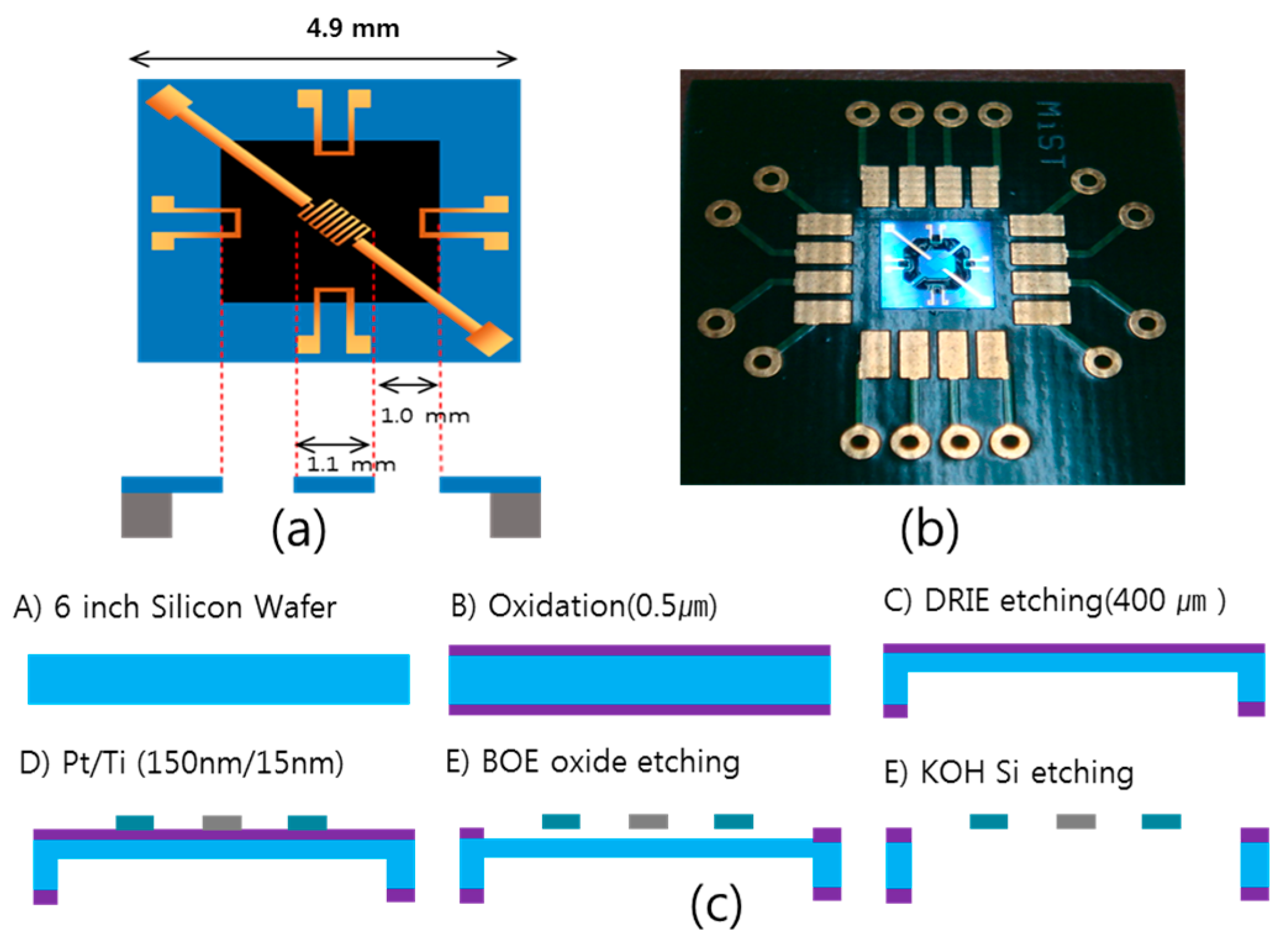
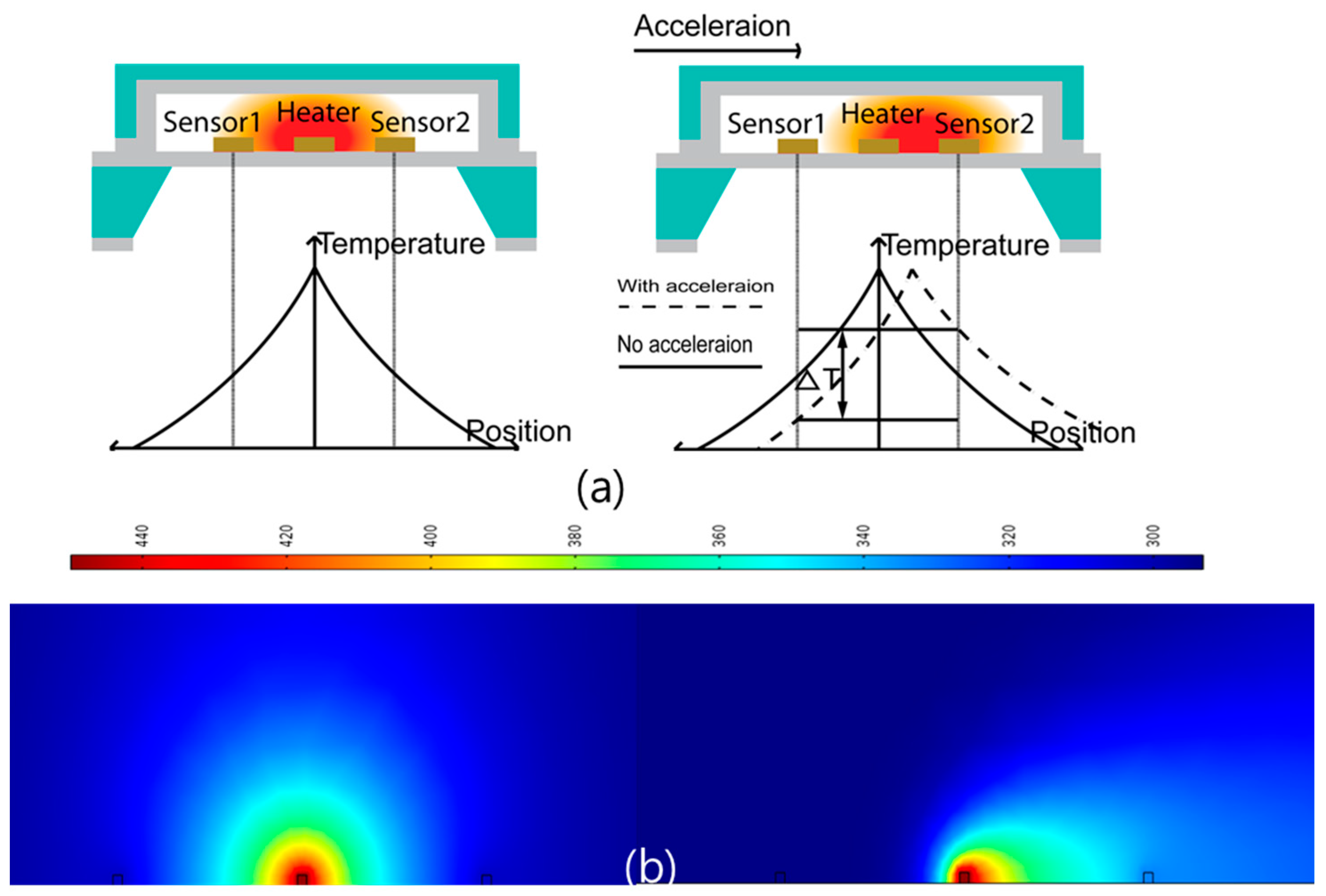

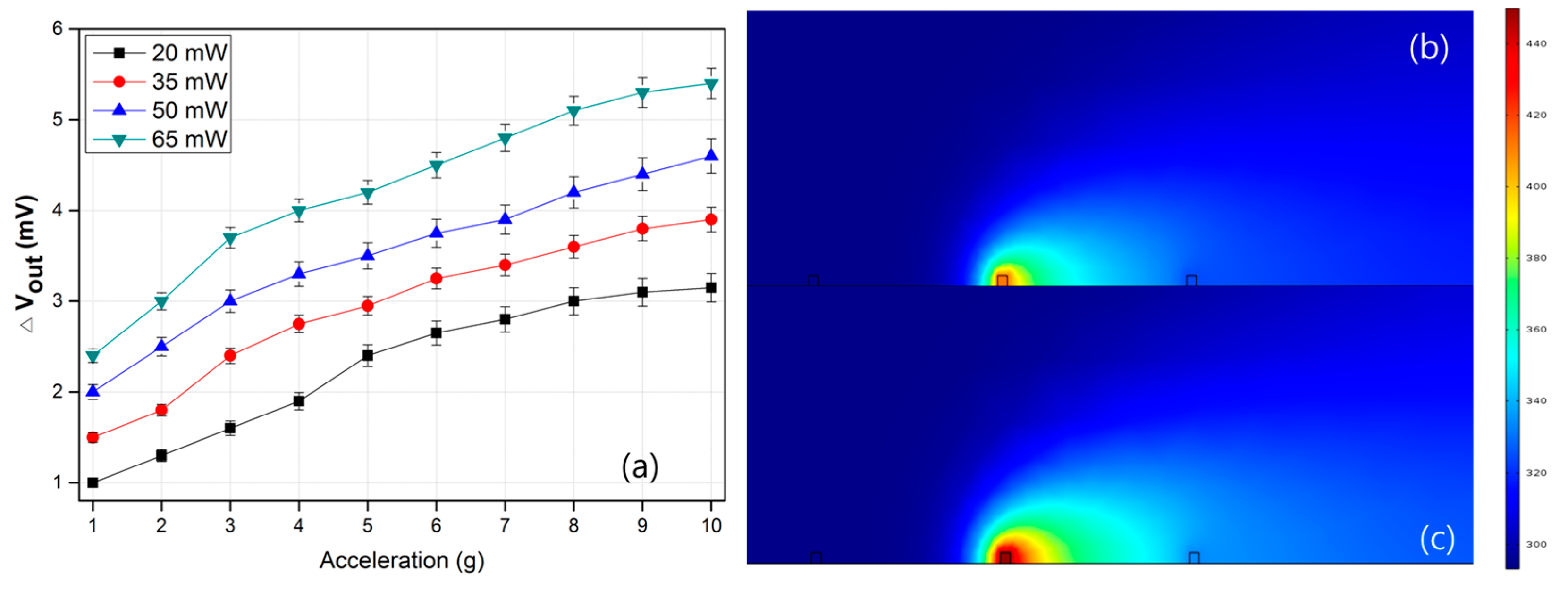
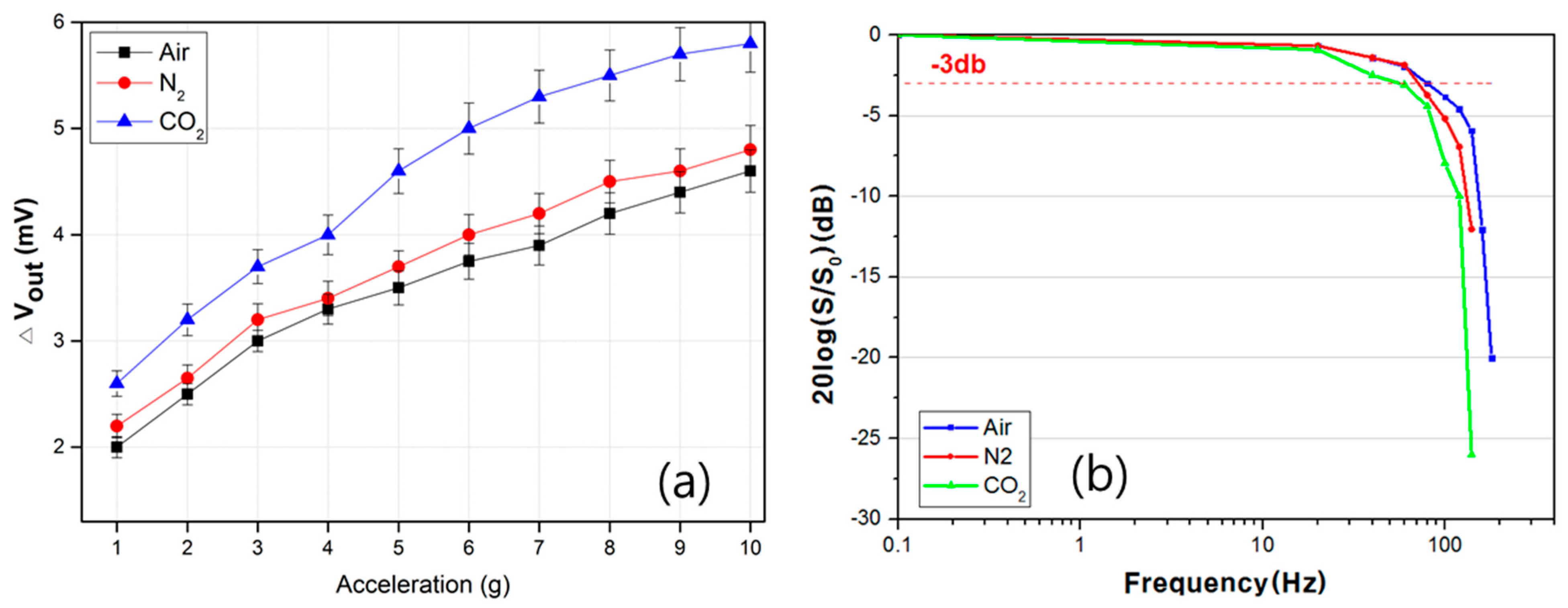
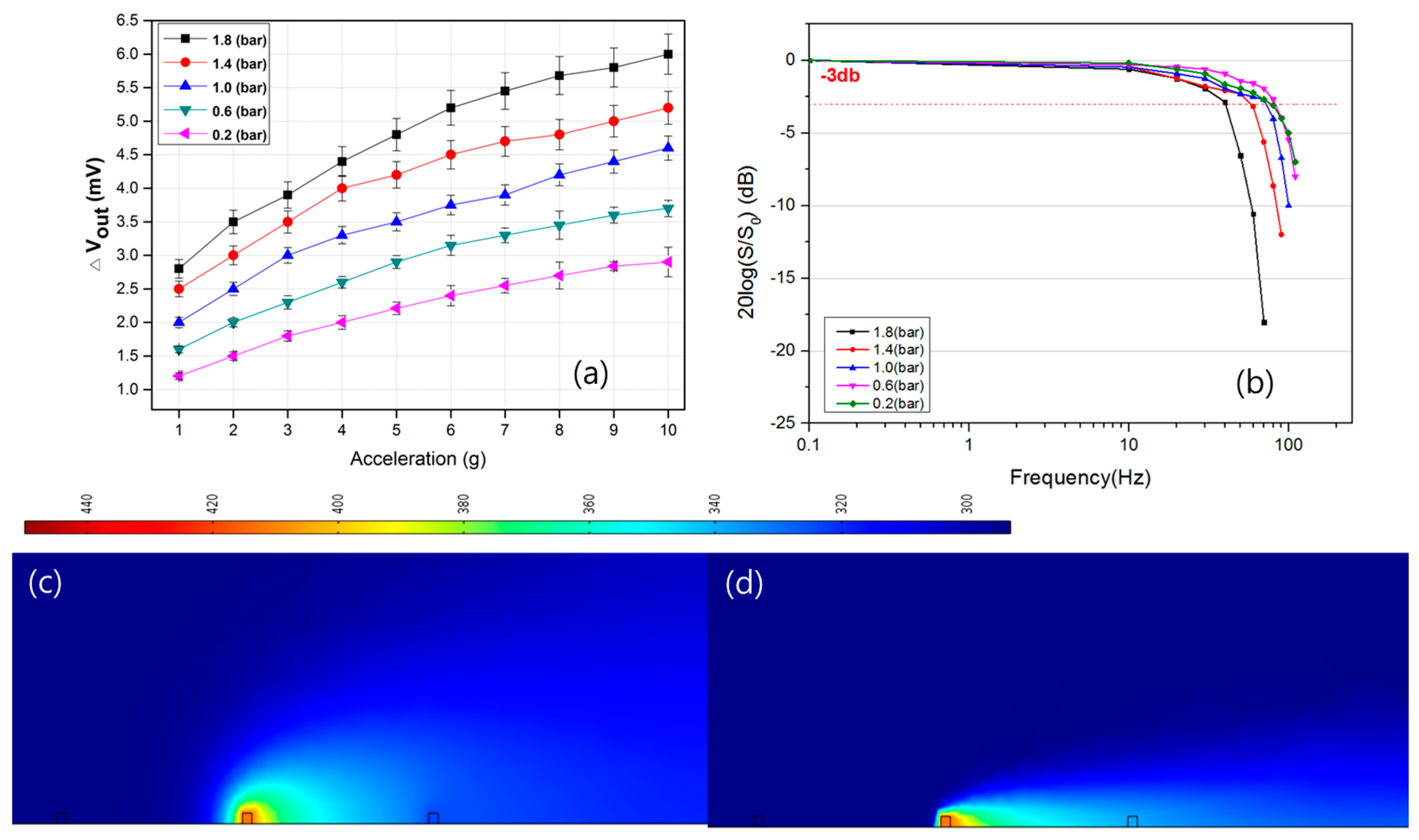
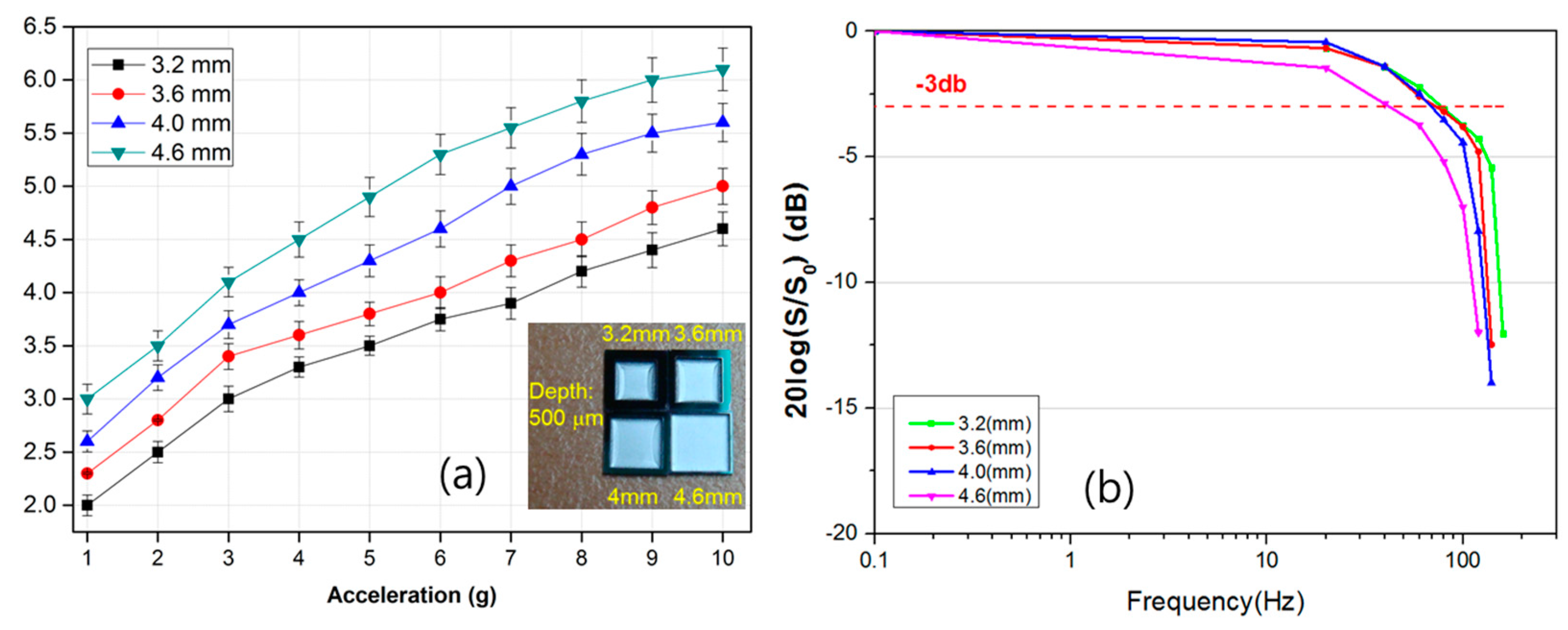
| Density (kg/m3) | Specific Heat (kJ/kg·K) | Kinematic Viscosity (×10−6) (m2/s) | Thermal Diffusivity (×10−4) (m2/s) | Thermal Conductivity (W/m·K) | |
|---|---|---|---|---|---|
| Air | 1.092 | 1.007 | 19.6 | 0.248 | 0.02735 |
| N2 | 1.0564 | 1.042 | 17.74 | 0.249 | 0.02746 |
| CO2 | 1.6597 | 0.8666 | 9.71 | 0.129 | 0.01858 |
© 2017 by the authors. Licensee MDPI, Basel, Switzerland. This article is an open access article distributed under the terms and conditions of the Creative Commons Attribution (CC BY) license (http://creativecommons.org/licenses/by/4.0/).
Share and Cite
Han, M.; Kim, J.K.; Park, J.-H.; Kim, W.; Kang, S.-W.; Kong, S.H.; Jung, D. Sensitivity and Frequency-Response Improvement of a Thermal Convection–Based Accelerometer. Sensors 2017, 17, 1765. https://doi.org/10.3390/s17081765
Han M, Kim JK, Park J-H, Kim W, Kang S-W, Kong SH, Jung D. Sensitivity and Frequency-Response Improvement of a Thermal Convection–Based Accelerometer. Sensors. 2017; 17(8):1765. https://doi.org/10.3390/s17081765
Chicago/Turabian StyleHan, Maeum, Jae Keon Kim, Jin-Hyoung Park, Woojin Kim, Shin-Won Kang, Seong Ho Kong, and Daewoong Jung. 2017. "Sensitivity and Frequency-Response Improvement of a Thermal Convection–Based Accelerometer" Sensors 17, no. 8: 1765. https://doi.org/10.3390/s17081765





